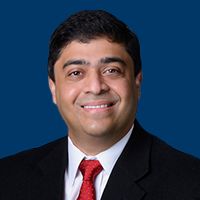Video
Patient Profile 2: Former Smoker Diagnosed With NSCLC
Author(s):
David H. Harpole Jr, MD, presents a case of a former smoker diagnosed with NSCLC, and David Spigel, MD, offers his initial impressions.
EP: 1.Multidisciplinary Care in Non-Small Cell Lung Cancer
EP: 2.Patient Profile 1: A 57-Year-Old Woman Diagnosed With NSCLC
EP: 3.Workup and Molecular Testing for a Patient with NSCLC
EP: 4.Treatment Approach for Patients With Stage IB Disease
EP: 5.Adjuvant Therapy in Early Stage NSCLC
EP: 6.Therapies Targeting Specific Molecular Alterations in NSCLC
EP: 7.Choosing Appropriate Patients for Surgical Resection in NSCLC
EP: 8.Patient Profile 2: Former Smoker Diagnosed With NSCLC
EP: 9.Treatment Approach for Patients With Stage II-IIIA NSCLC
EP: 10.Neoadjuvant Therapy and Other Emerging Therapies in Early Stage NSCLC
EP: 11.Unmet Needs and Future Perspectives in the NSCLC Treatment Landscape
Transcript:
David Spigel, MD: Let’s move forward…David, I think you had a case you wanted to take us through.
David H. Harpole Jr, MD: I wanted to [show] a patient where it’s really unclear on which side of the fence this patient would sit. I think we’re seeing more of these locally advanced patients. This is someone I just saw recently who is a former smoker, significant history, not great pulmonary functions, but OK, and pretty reasonable performance status, who presented with this large mass of 5 cm to 6 cm on the right side.
These are more images. First of all, the upper panel shows that it’s near the upper lobe bronchus where the PET [positron emission tomography] had a questionable N2 node. Then there’s the lesion that you can see.
The patient had a negative head MRI [magnetic resonance imaging], and the PET was otherwise negative. They underwent an EBUS-FNA [endobronchial ultrasound-guided fine-needle aspiration] with negative mediastinal nodes, but a positive 11R(+) or higher node. The bronchoscopy by the interventional pulmonary person showed tumor out in the segments of the upper lobe, which they biopsied as adenocarcinoma, and they called it T2-3 N1.
There are a lot of treatment options here. First I’ll probably ask each of my partners here, could you push this as a nonsurgical route? Which one could do. Could you push it to a surgical and adjuvant route? That’s certainly not unreasonable. Or would you push it toward the more exciting neoadjuvant approaches [such as] the CheckMate 816 type pathway? David, what do you think?
David Spigel, MD: It’s a great case because you highlight the excitement. Certainly the management of stage III cancer has generally shifted more toward unresectable care with chemotherapy-RT [radiotherapy] followed by immunotherapy for true stage III cancer that we would say is probably not ideally resectable, [it is] multistation or bulky. This case is a bit different because it’s N1 disease, not N2 disease. I would think if a patient was an operable candidate, you’d want to offer them surgery.
But let’s pretend for the moment that she had N2 disease, the PET maybe suggests that. The question is, do you just say that surgery is off the table with N2 disease, or do we say surgery’s reasonable because it’s single station and low volume? And now I may be able to downstage her, so to speak, with a neoadjuvant approach, specifically CheckMate 816.
[That was] a randomized trial that Patrick Forde, [MBBCh,] from Johns Hopkin led where patients got oddly 3 cycles of platinum doublet chemotherapy with the PD-1 inhibitor nivolumab, or chemotherapy alone. The goal of the study was to look at pathologic CR [complete response] rate…. The advantage was clearly in favor of nivolumab. It was [about] a 25% pathologic CR rate vs 2% with chemotherapy alone. Surgical outcomes did not appear to be affected, maybe even less invasive surgery was done. So could you take somebody say who was marginally resectable before and make them more resectable because of this deep response rate and change the playing field? That seems to be the question right now, and I don’t have a perfect answer. I guess I’m trying to take everybody from neoadjuvant therapy who we think is a good candidate for it, but if we don’t think it’s likely that surgery is ever in the cards, then I probably would say let’s just move ahead and give definitive chemoradiation.
Transcript edited for clarity.









